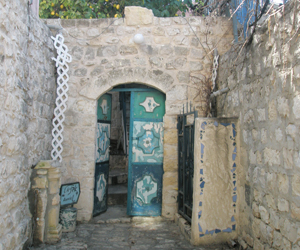Tzfat 2006
A Surprise for All
Israel is a country with many security issues. So when war broke out in July 2006, most of the world seemed to take it for granted.
Not so for the people of the North, who, with no notice, found themselves under rocket fire after a Hezbollah cross-border attack in which two Israeli soldiers were kidnapped.
The Katyusha rockets are not new to the border settlements of the North. Kiryat Shmoneh, Metulla, Ma'a lot and Nahariya, together with the surrounding villages and farms, have, in the past, often been fired upon from Southern Lebanon. The rest of Israel grew used to hearing that the Northern towns were being fired upon whenever the current power in Southern Lebanon became annoyed. Israelis would read about the Northern residents being sent to their bomb shelters, and then would go about their daily business without much other thought.
July 2006 was a benchmark, because it was the first time that towns and cities well south of the previous confrontation line were hit. Tzfat was the first, and most frequent target of the Hezbollah, which fired almost 700 Katyushas at Tzfat throughout the month-long war. Most of the rockets were aimed at the Tzfat hospital, which was hit once.
Still a City of Miracles
Yet throughout the barrage, one can look at Tzfat and say "miracles still happen". Dozens of the Katyushas landed in densely-populated areas of the city, yet only one man was killed, and of those injured, all have recovered. The hospital was hit, but the area which was impacted was unpopulated at the time.
Several rockets landed in the lanes of the Old City. One scored a direct hit on a family of seven which had just sat down for dinner in their small house - all members of the family, though injured, survived, and within 2 weeks were strong enough to be evacuated to a rest house in the South. In the crowded Ethiopian Absorption Center in the south of the city, the one unoccupied apartment, the Center's office, was hit.
A Katyusha destroyed a girls' seminary in the Old City, yet the ancient synagogues which are located on either side of the school, one with Torah scrolls dating back hundreds of years, were unscathed. None of the volunteers who came to Tzfat to help assist the residents of the city were hurt, though they moved through the city daily under constant rocket barrage.
Finally, one of the most remarkable stories took place one Friday night, when the "regulars" of two old synagogues met to hash out which synagogue they should pray in for Friday night prayers - there weren't enough men for two prayer quorums, so they had to decide to pray in one synagogue or the other. After hours of arguing, they finally agreed to go to one of the synagogues. Then, in the middle of the prayers that Friday night, the second synagogue, the one they chose not to pray at, took a direct hit.
Few people would want to repeat the experience of the summer of 2006, yet there is little argument that if an emergency situation were to break out again, most residents would feel that Someone watches Tzfat.
Also check out our article on project resilience about rebuilding Safed after the war.

